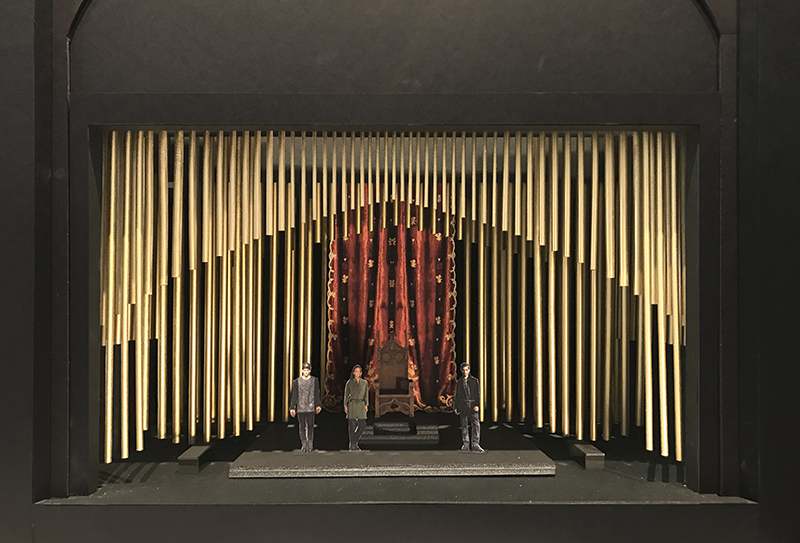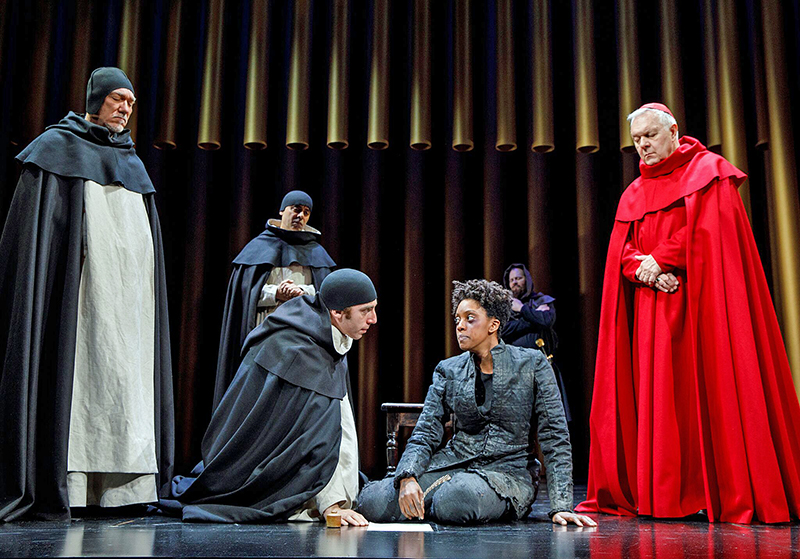The recent Broadway revival of George Bernard Shaw’s Saint Joan starred Condola Rashad as Joan of Arc, the teenager who ascended from seemingly loony French patriot to fierce warrior and unifier of her people against English subjugation. But once her usefulness was over and the Catholic Church deemed her a threat to patriarchal rule, she was condemned to death for being a heretic, particularly because she claimed she saw and heard saints who guided her actions. It’s an ultimately tragic story set against the backdrops of palatial confrontations, epic battles and intimate intrigues.

Sculpting the Space
Naturally, it is hard to capture such a wide scope of locations with a limited amount of stage space, and there was a need to imply some action offstage, so scenic designer Scott Pask, working in tandem with projection designer Christopher Ash, invented an unusual solution. He created a striking set where the major scenic piece was a group of golden tubular bells hanging from the ceiling, which could move into different configurations to represent different types of spaces. In one sense, the bells play off the fact that the Vatican is full of gold, and Pask says that his set had such regal aspirations. Deciding upon hanging many rows of movable tubular bells was an unusual choice, and the first row was cut and shaped to look like an open curtain.
While the bells may have looked heavy, they were made out of various materials — some were PVC, some were cardboard fiber, and all were wrapped. Some were heavier than others. “If they were made out of PVC, we kept those to the thinner tubular bells,” says Pask. “It was all kind of manageable.”
Pask recalls that he and director Daniel Sullivan wanted to create an environment “that was more a poetic crucible for the play as opposed to a literal jumping from scene to scene and creating naturalistic locales,” he says. Sullivan decided to investigate tubular bells, a chime-like instrument that duplicates the sound of church bells, to see if that choice might influence anything, so Pask researched them and other instruments of the period. (For fans of contemporary music, tubular bells can be heard on albums by Pink Floyd, ELP and Culture Club. Mike Oldfield’s famous recording of the same name was excerpted for the horror film The Exorcist.)

Artistic Liberties
Saint Joan is set between 1429 and 1456 A.D., and tubular bells first emerged in France in the mid-1800s. Many history buffs and music scholars might protest this inaccuracy, but Pask says he was “riffing on musical instruments of the time. Tubular bells were developed later, but the church organ and things like that were [earlier] versions of that. It’s taking inspiration and making it nonspecific, being more open to a breadth of visual interpretation.”
As Pask observes, the play has its abstractions, and a contemporary epilogue that features numerous main characters in ghostly form congregating many years after her death, with one person arriving from the 20th Century to let Joan know how she will become perceived through the ages. “There’s something about the scale of a tubular bell and really amping it up,” says Pask about the play’s major scenic choice. “It has the colossal visual weight of the story, but then there’s ability for them to transform. I just sat down and sketched a version or two of it and then put a rough model together to show Dan. He was excited about it, so we continued with a big 1/2” scale model.”
Originally, Pask and Sullivan contemplated a sense of perspective where the tubular bells were much smaller upstage, then became bigger going downstage, but they ended up reversing that choice, starting larger backstage and diminishing the size of the bells as they moved downstage. “The portal of tubular bells that’s downstage is the most delicate,” says Pask. When characters were running around the bells upstage, “[that] became important when I was considering Joan’s imprisonment and the math of it, how she was almost dwarfed by them at that point when she was shown in relief against the most upstage row of those bells. They were quite colossal.”
The paint used was “a hybrid of gold and brass paint with gradations of some other patinas on each of the tubular bells,” explains Pask. “In order to keep it bright and transformative and also to be able to accept the projections, we kept it in that world of golds and brasses. They got a little deeper in tone at the top and the bottom. That color worked brilliantly well when we were in the palace, and it could be foreboding when we removed from light from it” for scenes outside of the palace.
According to Pask, the shape of the bells worked well with Christopher Ash’s projections, which included smoke, fire, clouds and stars as well as textural images during transitions. “The shape of the tubular bells allowed the theatrical and projected light to roll over them in a more interesting way instead of a flat surface,” says Pask. “It made a more interesting projection surface and made it a little bit more abstract, which was helpful for the environment we were trying to create.”
The tubular bells have a header that can adjust their opening shape. The second portal of tubular bells can adjust its shape from a pointed arch to a rectangular opening. “The way that it was engineered was unique because each bell was hanging separately from a batten overhead that rose at the center to create this pointed arch and then lowered to create a flattened opening. I loved watching that transition.” There were five planes of bells to the plaster line onstage.
The symmetrically layered tubular bells were hung on individual points, with the ones that traveled hung on sections of individual rigged traveler track. During the epilogue, the bells moved as if caught in wind. Pask says he demonstrated their potential on the first day of tech by dragging his hand across them. “They really moved, and then very quickly settled back into their positions,” he recalls.
Pask never worried about the scenery getting stuck, but once in a while they did not settle back into perfect vertical. A system was developed for stage management to check the present each day and make sure that it was monitored and could be properly adjusted during performances.
PRG created the sets, and Scenic Arts studio painted them. The set was built in six to eight weeks, and the design process took a little bit longer. Pask started designing for the show around Thanksgiving of last year and wrapped up by the end of the year as they were in bid before Christmas. The sets were being constructed in January.

Multiple Locales
The most challenging aspect of Joan’s design work, according to Pask, was “a sequence of many places and making sure that each of them was being well served,” he says. The furniture pieces were all being moved by the cast, so he wanted the flow of such action to not compromise any entrance or exit. He adds that the transitions were always a challenge, “especially as this was a play that almost moved like a musical.”
The props and set pieces included a staging precinct that was 10 inches off the proper deck and approximately 20 feet wide by 20 feet deep. There was also a throne, a few highback chairs, and an 18th century footstool. All the chairs were based on the period, “and I think we got a couple of antiques,” says Pask. “The bed was made from some antique panels that we found online, and we made the bed around those panel proportions.”
While some productions like to keep the curtain lowered until show time, audiences for Saint Joan saw the set right when they came in. Pask says that he and Sullivan discussed whether or not they should do that, and the designer admits that the child in him likes to have that curtain reveal and the intake of breath from audience members at witnessing something impressive for the first time. With this show, audiences got to know the set and before being introduced to the cast.
The scenic design for Saint Joan fit its venue well. The Samuel J. Friedman Theatre is a space that Park is very familiar with. He worked on Little Foxes there last year, and his other recent productions there have included The Father, Airline Highway and Casa Valentina. “The Friedman is a theater that you always get a new facet of its personality,” remarks Park. “It’s a beautiful space and it’s a great scale. It doesn’t fan out wide from the side, so it’s one of those perfect sight line theaters, and it’s such a jewel box. There’s just something about the interior color that I’ll think about, and this one I put in a black portal just to really separate the onstage world from the front of house world.”
Projected Precision
Pask says that he was impressed with Christopher Ash’s projections, which he calls amazing because “they were wedged into such a small position upstage behind the last row of these vertical tubular bells, but they were actually projecting behind there and were done with mirrors. I just haven’t seen anything that successfully done with such a narrow throw distance. I think that was an incredible accomplishment on Christopher Ash’s part. It was really beautiful when the smoke was coming through various textures. I thought that was pretty fascinating, and it worked in tandem with balcony rail projection. I loved watching how [his projections] behaved on the bells, and he was very meticulous about masking off at the spaces in between, which is important so you’re not bleeding all over the rest of the room.”
Throughout his career, Pask has created diverse sets for a wide variety of shows, from the practical, Tudor-inspired sets of Something Rotten to the pie-focused proscenium arch displays of Waitress to the video intensive, curved backdrop of Mean Girls. “I think in order for me to feel good about the work that I’m doing right, I need to be a chameleon and I need to do what’s best for the show,” he explains.
Pask feels that his scenic design work should not feel like it is impressed on a production. “It really needs to feel like it’s the inevitable solution, but done in a way that you would not expect,” he says. “I think that if it starts feeling like you’re impressing things on a production then it suffers under that weight.”
He is all for ambition and trying new things, but Pask believes that it is important that the technical side of things “gets out of the way, especially for new productions of a new play or musical. That the technical things can step outside and let the work that is being done on that piece keep evolving and keep happening. And that there’s not an impediment on the technical design side of things to keep progress. Especially when things are in a process of discovery.”


